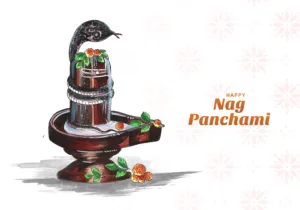Nag Panchami is a traditional Hindu festival dedicated to the worship of serpents observed mostly in India, Nepal, and other countries with a significant Hindu population. Celebrated on the 5th day of the bright half of the lunar month of Shravan (July/August) Nag Panchami holds tremendous spiritual and social value. The festival represents the deep-seated reverence and respect that Hindus have for all forms of life especially the serpent deities referred to as Nagas, which play a crucial role in Indian mythology and folklore.

Mythological Significance
The reverence for snakes in Hinduism can be traced back to ancient scriptures and mythologies. In Hindu mythology, Nagas are semi-divine beings who are considered powerful and are often associated with water bodies such as rivers, lakes, and seas. They are depicted as half-human together and half-snake embodying both the fearless and benevolent aspects of nature.
Among one of the most prominent myths connected with Nag Panchami is the tale of Lord Krishna together with Kaliya, the serpent. According to the Bhagavata Purana the young Krishna, while playing near the Yamuna River encountered the venomous serpent Kaliya who had poisoned the waters and had terrorized the people. Krishna, in his divine form, subdued Kaliya by dancing on his hoods eventually forcing him to leave the river and promise not to harm anyone. This tale is emblematic of the victory of good over evil and the protection of nature.
Rituals and Traditions
The observance of Nag Panchami varies across regions but several common practices and rituals are followed. On this day devotees offer milk, sweets, flowers, and also various other offerings to serpent idols or living serpents often represented by the cobra, which is considered the most sacred among serpents.
The Role of Temples
Temples dedicated to snake gods, such as the famous Nag temples in Kerala and other parts of South India, become centers of devotion and activity. Devotees gather in these temples to do pujas (ritualistic worship) and seek blessings for prosperity and protection from snake bites. The Sree Nagaraja Temple in Mannarasala, Kerala, is one of the most renowned temples where thousands gather to offer their prayers.
The Significance of Milk
Offering milk to serpents is one of the most significant rules of Nag Panchami. It is believed that the deities come down to the earthly realm on this day to accept the offerings. While some believe that the practice of offering milk to serpents has its origins in making certain of the well-being of serpents during the monsoon period others see it as a symbol of nurturing and respect.
Symbolic Drawings and Decor
In many parts of India, women draw images of serpents on the walls and floors of their homes using a mix of cow dung and turmeric. These drawings, known as Nagavalli or Nagamandala, are accentuated with vermilion flowers. They symbolize protection against snake bites and bad omens. In Maharashtra, Bengal, and also other states people make clay or wood models of serpents, which are then worshipped.
Regional Variations
Nag Panchami celebration shows fascinating regional diversity reflecting the cultural richness of India.
South India
In South India especially in Karnataka and Andhra Pradesh Nag Panchami is celebrated with grand processions and elaborate rituals. People visit anthills which are considered abodes of serpents and offer milk and prayers. The day is also marked by snake charmer performances, folk dance, and music.
Maharashtra
In Maharashtra, the festival coincides with the monsoon period, and devotees flok to temples offering prayers to Nagas. The womenfolk often fast on this day, seeking the well-being of their brothers and families. The legend of the 5 Nagas Ananta, Vasuki, Shesha, Padmanabha, and Kambala is recited, highlighting their value in Hindu cosmology.
Bengal and Northeast India
In Bengal and the Northeastern states, the festival is known as Manasa Puja, dedicated to the serpent goddess Manasa. Devotees offer flowers, fruits, and milk to the goddess and seek protection from snakebites and various other calamities. Folk songs and dances depicting the tales of Manasa Devi are a major part of this festival.
Environmental and Cultural Impact
Nag Panchami is more than just a simple spiritual celebration; it has a profound environmental and cultural impact. The festival underscores the relevance of serpents in the environment as controllers of rodent populations and indications of environmental health. By worshipping snakes, Hindus emphasize coexistence and the need to secure wildlife.
Furthermore, Nag Panchami fosters community bonding and cultural community. The collective participation in rituals, storytelling, and festivities strengthens social connections and preserves the rich heritage of mythology and folklore.
Conclusion
Nag Panchami is a testament to the sophisticated tapestry of Indian culture, where mythology, religion, and environmental consciousness interact. It is a day when serpents, often feared and misunderstood are celebrated for their unique place in the natural world and the divine realm. With rituals, tales, and community activities Nag Panchami continues us to remind of the delicate balance between humans and nature urging us to respect and cherish all life forms.